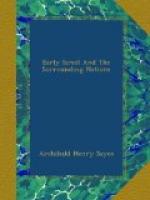Egypt, once the house of bondage, thus became a second house of Israel. It gave the world a new version of the Hebrew Bible which largely influenced the writers of the New Testament; it gave it also a new Canon which was adopted by the early Christian Church. The prophecy of Isaiah was fulfilled: “The Lord shall be known to Egypt, and the Egyptians shall know the Lord.”
In the course of centuries, however, the monotheistic element in Egyptian religion had grown clearer and more pronounced in the minds of the educated classes. The gods of the official cult ceased to be regarded as different forms of the same deity; they became mere manifestations of a single all-pervading power. As M. Grebaut puts it: they were “the names received by a single Being in his various attributes and workings.... As the Eternal, who existed before all worlds, then as organiser of the universe, and finally as the Providence who each day watches over his work, he is always the same being, reuniting in his essence all the attributes of divinity.” It was the hidden God who was adored under the name whatever the latter might be, the God who is described in the texts as “without form” and “whose name is a mystery,” and of whom it is said that He is the one God, “beside whom there is no other.” In Ptah of Memphis or Amon of Thebes or Ra of Heliopolis, the more educated Egyptian recognised but a name and symbol for the deity which underlay them all.
Along with this growth in a spiritual conception of religion went, as was natural, a growth in scepticism. There was a sceptical as well as a believing school, such as finds its expression in the festal Dirge of King Antef of the Eleventh dynasty. Here we read in Canon Rawnsley’s versified translation—
“What is fortune? say
the wise.
Vanished
are the hearths and homes,
What he does or thinks, who
dies,
None
to tell us comes.
Eat and drink in peace to-day,
When
you go, your goods remain;
He who fares the last, long
way,
Comes
not back again.”
A curious work of much later date that has come down to us is in the form of a discussion between an Ethiopian cat and the unbelieving jackal Kufi, in which the arguments of a sceptical philosophy are urged with such force and sympathy as to show that they were the author’s own. But such scepticism was confined to the few; the Egyptian enjoys this life too much, as a rule, to be troubled by doubts about another, and he has always been distinguished by an intensity of religious belief.




